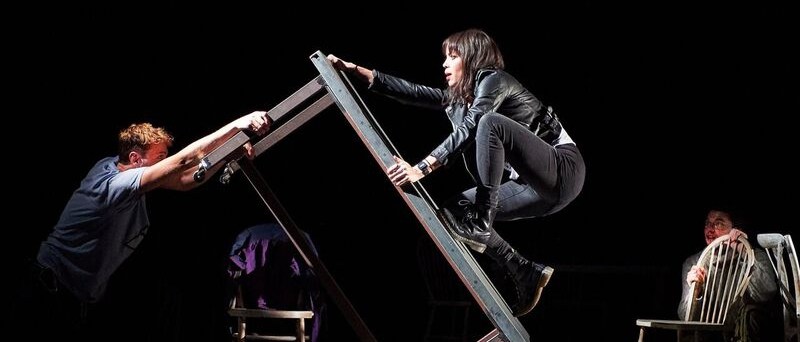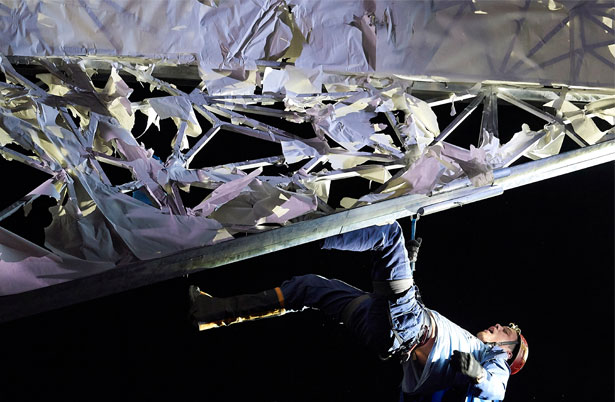
How do you capture the scale, the struggle, the elemental extremity of mountain climbing? In the theatre? It’s simpler than you think. After all, they both use the same kit.
Touching the Void is based on the true story of two young Brits attempting to scale a never-scaled face of the Siula Grande mountain in the Peruvian Andes. David Greig’s adaptation has found its purest home in old proscenium theatres – the venerable Bristol Old Vic (which first welcomed Georgian audiences in 1766), where Tom Morris’ production began, Edinburgh Lyceum Theatre from 1883, Northampton’s 1884 Royal and now another Victorian house, the Duke of York’s Theatre (1892) in London.
Plush and gilt, boxes, scrolls and chandeliers – these will surely be the least likely frame for a story that mostly takes place at towering altitudes, in ice-lashed winds and miles from the nearest human? But theatre has been in the business of climbing and scaling, of suspending bodies along with disbelief, of dreaming the impossible dream via rope and metal, for centuries now.
When I interviewed the designer Es Devlin a while back, she showed me one of her favourite books, a Victorian manual of stage illusion. She was talking about a play called The Nether, set in a futuristic world, but pointed out that, ‘despite appearances, it’s a very simple design, not at all hi-tech… classic smoke and mirrors. At the Royal Court, the stage crew used 19th-century manual hemp-rope counterweights to change the scenery.’
A friend whose veins run with theatre and seafaring often mentions the crossover between mariners and stagehands. All the theatres that Touching the Void has visited would, for much of their early lives, have used painted backcloths. Their scenic effects, says my pal, were ‘dependent on sailcloth and decommissioned sails, put together in sail-lofts along the working river, rope-rigged and hauled by ex (sometimes temporarily so) mariners.’ Similar tackle was used for the flying that marks every festive Peter Pan (and, for the ballet crowd, Giselle).
What does this mean? It means ropes and wires and clips and harnesses. Things for hauling, things for holding – especially for holding, because fingers are fallible and if things slip through it spell disaster (falling to your doom; disrupting a matinee). Securing everything tight is paramount – and for that you need cords and belays, carabiners and quickdraws, things that grip and connect and keep you safe.
For much of Touching the Void, we see this strange world of ultimate risk through the eyes of Sarah (Fiona Hampton), sister of one of the Andean adventurers. We have to be made to feel the thrill of climbing, as well as its dangers and cruel moral choices. So, to give her a taste, the climbers pile furniture from the opening pub scene – long wooden tables, sketchy wooden chairs – up the side of the proscenium arch, reaching to the circle boxes. And, slowly, determinedly, Sarah grapples and hauls herself upwards – up the sheer face of the table, around the jutting spars of chair legs – until she triumphantly attains the upper circle. Sat right at the front, my moonface turned upwards too, neck craned back, jaw slack with delight. I love this – being shown how illusion is achieved without any apparent pretence, but falling for it anyway.

To be honest, nothing else in the show gave me quite that thrill, involving though it was (and, though I’d seen the 2003 documentary, I’d totally forgotten crucial details of who survived the expedition, which kept things tense). The situation has more weight than the characters, and nothing in the ingenuity of Ti Green’s design is quite as exciting as that no-frills early sequence. But that climb up the pros is a corker – and the props that make it happen are vital to reaching the heights, whether nestled on stage or against the sky.
Follow David on Twitter: @mrdavidjays

Leave a Reply